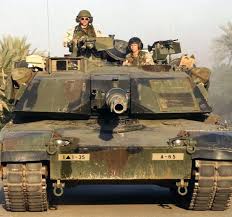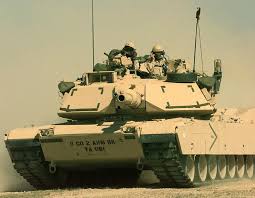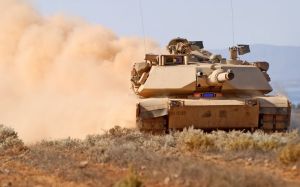
The M1 Abrams is powered by a 1500 hp (1119 kW) Honeywell AGT1500 (originally made by Lycoming) gas turbine, and a six speed (four forward, two reverse) Allison X-1100-3B Hydro-Kinetic Automatic transmission, giving it a governed top speed of 45 mph (72 km/h) on paved roads and 30 mph (48 km/h) cross-country. With the engine governor removed, speeds of around 60 mph (100 km/h) are possible on an improved surface; however, damage to the drive train (especially to the tracks) and an increased risk of injuries to the crew can occur at speeds above 45 mph. The tank can be fueled with diesel fuel, kerosene, any grade of MOGAS (motor gasoline), or JP-4 or JP-8 jet fuel; the U.S. Army uses JP-8 jet fuel in order to simplify logistics. The gas turbine propulsion system has proven quite reliable in practice and combat, but its high fuel consumption is a serious logistic issue (starting up the turbine alone consumes 40 liters of fuel).
The high-speed, high-temperature jet blast emitted from the rear of M1 Abrams tanks makes it difficult for the infantry to proceed to shadow the tank in urban combat. The turbine is noisy, comparable to a helicopter engine, although the noise character (pitch) is significantly different from a contemporary diesel tank engine, reducing the audible distance of the sound, thus the nickname, “Whispering Death”. Future US tanks may return to reciprocating engines for propulsion, as 4-stroke diesel engines have proven quite successful in other modern heavy tanks, e.g. the Leopard 2, Challenger 2 and Merkava. The small size, simplicity, power-to-weight ratio and easy removal/replacement of the turbine power pack does, however, present significant advantages over any proposed reciprocating replacement.
The Abrams can be carried by the C-5 Galaxy and C-17 Globemaster III. The limited capacity (one combat-ready tank or two transport-ready tanks in a C-5, one combat-ready tank in a C-17) caused serious logistical problems when deploying the tanks for the First Gulf War, though there was enough time for 1,848 tanks to be transported by ship.



















You must be logged in to post a comment.